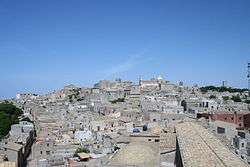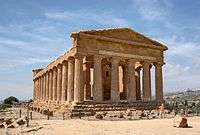Erice
- For the Spanish film director, see Victor Erice.
| Erice | |
|---|---|
| Comune | |
| Città di Erice | |
|
View of Erice | |
 Erice Location of Erice in Italy | |
| Coordinates: IT 38°2′13″N 12°35′11″E / 38.03694°N 12.58639°ECoordinates: IT 38°2′13″N 12°35′11″E / 38.03694°N 12.58639°E | |
| Country | Italy |
| Region |
|
| Province / Metropolitan city | Trapani (TP) |
| Frazioni | Ballata, Casa Santa, Crocefissello, Napola, Pizzolungo, Rigaletta, San Cusumano, Torretta |
| Government | |
| • Mayor | Giacomo Tranchida (since 2007) |
| Area | |
| • Total | 47 km2 (18 sq mi) |
| Elevation | 751 m (2,464 ft) |
| Population (November 30, 2005) | |
| • Total | 28,880 |
| • Density | 610/km2 (1,600/sq mi) |
| Demonym(s) | Ericini |
| Time zone | CET (UTC+1) |
| • Summer (DST) | CEST (UTC+2) |
| Postal code | 91016 |
| Dialing code | 0923 |
| Patron saint | SS. Mary of Custonaci |
| Website | Official website |
Erice (Italian pronunciation: [ˈɛːritʃe]; Sicilian: Èrici ) is a historic town and comune in the province of Trapani in Sicily, Italy.
Geography
Erice is located on top of Mount Erice, at around 750 metres (2,460 ft) above sea level, overlooking the city of Trapani, the low western coast towards Marsala, the dramatic Punta del Saraceno and Capo San Vito to the north-east, and the Aegadian Islands on Sicily's north-western coast, providing spectacular views.
The bordering municipalities are Buseto Palizzolo, Paceco, Trapani, Valderice and Custonaci. The hamlets (frazioni) are Ballata, Casa Santa, Crocefissello, Napola, Pizzolungo, Rigaletta, San Cusumano and Torretta.
History

The ancient Greek name of Erice was Eryx (Έρυξ in Greek), and its foundation was associated with the eponymous Greek hero Eryx. It was not a Greek colony, as the Phoenicians founded it, but was largely Hellenized. It was destroyed in the First Punic War by the Carthaginians, and from then on declined in importance.
Eryx was conquered by Aghlebids in 831 and was renamed as Cebel Hamid (In Western sources Gebel Hamed, meaning Mountain of Hamid). It was ruled by Arabs until the Norman conquest. In 1167 the Normans renamed it Monte San Giuliano. It was known as Monte San Giuliano until 1934.
Main sights
In the northeastern portion of the city there are the remains of ancient Elymian and Phoenician walls indicating different stages of settlement and occupation in antiquity.
There are two castles that remain in the city: Pepoli Castle, which dates from Saracen times, and the Venus Castle, dating from the Norman period, built on top of the ancient Temple of Venus, where Venus Ericina was worshipped. According to legend, the temple was founded by Aeneas. It was well known throughout the Mediterranean area in the ancient age, and an important cult was celebrated in it. In his book On the Nature of Animals, Aelian writes that animals chosen for sacrifice would voluntarily walk up to the altar to be killed.
A cable car (funivia) runs since 2005 from the outskirts of Trapani to the town of Erice. The cablecar closes from mid January to mid March.
Culture
Erice hosts important scientific meetings at the Ettore Majorana center, organised by the controversial astrophysicist Antonino Zichichi. Also an annual Workshop on Molecular Gastronomy.
Gallery

The main church 
The Norman castle 
View towards Monte Cofano 
View towards Trapani 
Torretta Pepoli 
Clouds approaching Erice 
Hillside of Erice seen from the lowlands 
Remains of the ancient temple of venus 
Venus fountain 
Venus fountain 
Panoramic view from Erice 
Panoramic view from Erice 
Panoramic view from Erice 
Panoramic view from Erice 
Map of the Old City Wall
External links
| Wikivoyage has a travel guide for Erice. |
| Wikimedia Commons has media related to Erice. |
- Photo Gallery Erice
- Panoramic view from Erice castle
- Erice Photo Essay
- The Spanish family de Erice


